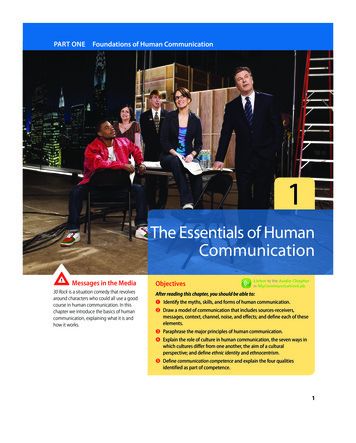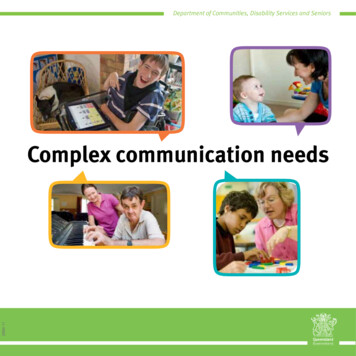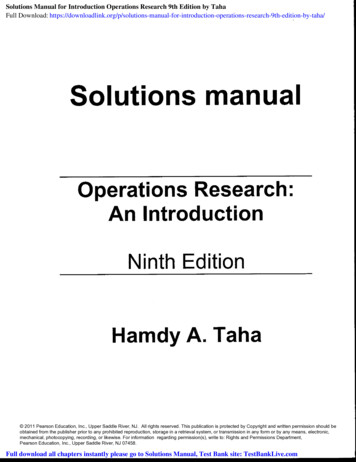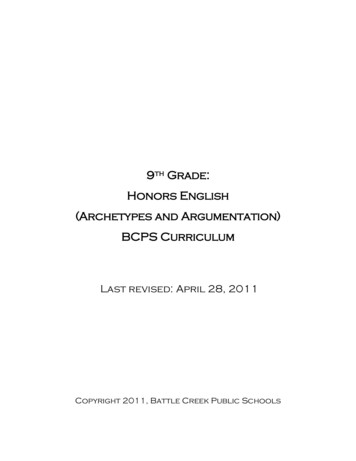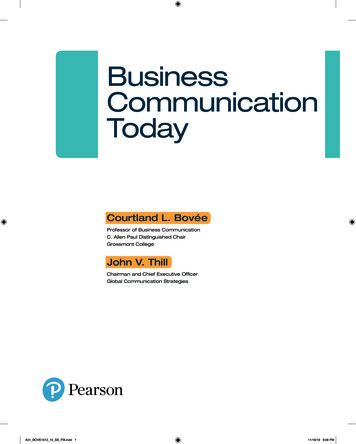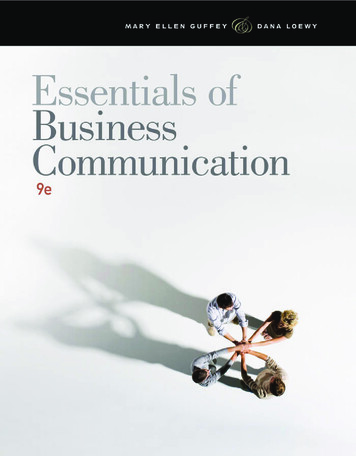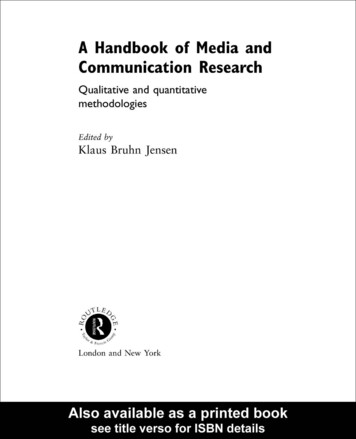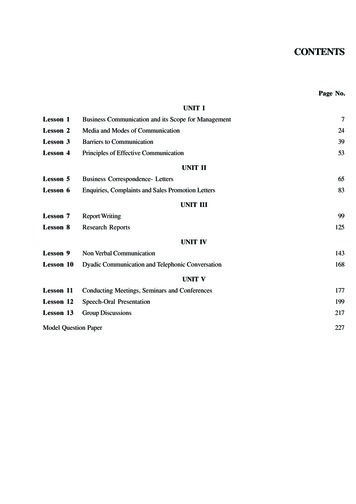
Transcription
Licensed to: CengageBrain User
Licensed to: CengageBrain UserThis is an electronic version of the print textbook. Due to electronic rights restrictions,some third party content may be suppressed. Editorial review has deemed that any suppressedcontent does not materially affect the overall learning experience. The publisher reserves the rightto remove content from this title at any time if subsequent rights restrictions require it. Forvaluable information on pricing, previous editions, changes to current editions, and alternateformats, please visit www.cengage.com/highered to search by ISBN#, author, title, or keyword formaterials in your areas of interest.Copyright 2012 Cengage Learning. All Rights Reserved. May not be copied, scanned, or duplicated, in whole or in part. Due to electronic rights, some third party content may be suppressed from the eBook and/or eChapter(s).Editorial review has deemed that any suppressed content does not materially affect the overall learning experience. Cengage Learning reserves the right to remove additional content at any time if subsequent rights restrictions require it.
Licensed to: CengageBrain UserEssentials of Business CommunicationNinth EditionMary Ellen Guffey, Dana LoewyVice President of Editorial, Business:Jack W. CalhounPublisher: Erin JoynerAcquisitions Editor: Jason Fremder 2013, 2010 South-Western, Cengage LearningALL RIGHTS RESERVED. No part of this work covered by the copyright hereinmay be reproduced, transmitted, stored, or used in any form or by any meansgraphic, electronic, or mechanical, including but not limited to photocopying,recording, scanning, digitizing, taping, web distribution, information networks,or information storage and retrieval systems, except as permitted underSection 107 or 108 of the 1976 United States Copyright Act, without the priorwritten permission of the publisher.Senior Developmental Editor: Mary H. EmmonsEditorial Assistant: Megan FischerMarketing Manager: Michelle LockardContent Project Manager: Jana LewisMedia Editor: John RichManufacturing Planner: Ron MontgomeryMarketing Communications Manager: SarahGreberFor product information and technology assistance, contact us atCengage Learning Customer & Sales Support, 1-800-354-9706For permission to use material from this text or product,submit all requests online at www.cengage.com/permissionsFurther permissions questions can be emailed topermissionrequest@cengage.comSenior Art Director: Stacy Jenkins ShirleyRights Acquisitions Specialist: Sam MarshallInternal Designer: KeDesign, Mason, OHExamView is a registered trademark of eInstruction Corp. Windows is a registeredtrademark of the Microsoft Corporation used herein under license. Macintosh andPower Macintosh are registered trademarks of Apple Computer, Inc. used hereinunder license. 2008 Cengage Learning. All Rights Reserved.Cover Designer: KeDesign, Mason, OHCengage Learning WebTutor is a trademark of Cengage Learning.Cover Image: Martin Barraud/Getty ImagesLibrary of Congress Control Number: 2011944636ISBN-13: 978-1-111-82122-7ISBN-10: 1-111-82122-4Student Edition ISBN 13: 978-1-111-82123-4Student Edition ISBN 10: 1-111-82123-2Production Service: Cenveo Publisher ServicesSouth-Western5191 Natorp BoulevardMason, OH 45040USACengage Learning products are represented in Canada byNelson Education, Ltd.For your course and learning solutions, visit www.cengage.comPurchase any of our products at your local college store or at our preferredonline store www.cengagebrain.comPrinted in the United States of America1 2 3 4 5 6 7 16 15 14 13 12Copyright 2012 Cengage Learning. All Rights Reserved. May not be copied, scanned, or duplicated, in whole or in part. Due to electronic rights, some third party content may be suppressed from the eBook and/or eChapter(s).Editorial review has deemed that any suppressed content does not materially affect the overall learning experience. Cengage Learning reserves the right to remove additional content at any time if subsequent rights restrictions require it.
ChapterLicensed to: CengageBrain User1Go tocengagebrain.comand use your access code tounlock valuable studenteResources. Dmitriy Shironosov/Shutterstock.comCommunication Skills as Career FiltersObjectivesAfter studying this chapter, you should be able to Appreciate how solid communication skills will improve your career prospects and help yousucceed in today’s changing workplace.Understand the process of communication.Begin practicing your listening skills and confront barriers to effective listening.Explain the importance of nonverbal communication and of improving your nonverbalcommunication skills.Recognize how culture influences communication and explain five common dimensions of culture.Discuss strategies that help you overcome negative cultural attitudes and preventmiscommunication in today’s diverse workplace.Communication Skills: Your Ticket to SuccessSmall superscript numbersin the text announceinformation sources. Fullcitations appear at the endof the chapter. This editionuses a modified AmericanPsychological Association(APA) reference format.2Workplace surveys and studies confirm that recruiters rank communication skillsat the top of the list of qualities they most desire in job seekers. Such skills arecrucial in a tight employment market when jobs are few and competition is fierce.In a recession, superior communication skills will give you an edge over other jobapplicants. A powerful career filter, your ability to communicate will make you marketable and continue to be your ticket to success regardless of the economic climate.Perhaps you are already working or will soon apply for your first job. Howdo your skills measure up? The good news is that effective communicationcan be learned. This textbook and this course can immediately improve yourcommunication skills. Because the skills you are learning will make a hugedifference in your ability to find a job and to be promoted, this will be one of themost important courses you will ever take.Why Writing Skills Matter More Than EverToday’s workplace revolves around communication. Workers communicate more,not less, since information technology and the Internet have transformed theworld of work in the last two decades. The modern office is mobile and fastpaced. Technology enables us to transmit messages faster, farther, to potentiallylarger audiences, and more easily than in the past. Many people work togetherChapter 1 Communication Skills as Career FiltersCopyright 2012 Cengage Learning. All Rights Reserved. May not be copied, scanned, or duplicated, in whole or in part. Due to electronic rights, some third party content may be suppressed from the eBook and/or eChapter(s).Editorial review has deemed that any suppressed content does not materially affect the overall learning experience. Cengage Learning reserves the right to remove additional content at any time if subsequent rights restrictions require it.
Licensed to: CengageBrain Userbut are physically apart. They stay connected through spoken and written messages. Writing skills, which were always a career advantage, are now a necessity.1A survey of American corporations revealed that two thirds of salaried employeeshave some writing responsibility. About one third of them, however, do not meetthe writing requirements for their positions.2“Businesses are crying out—they need to have people who write better,” saidGaston Caperton, business executive and College Board president.3 The ability towrite opens doors to professional employment. People who cannot write and communicate clearly will not be hired. If already working, they are unlikely to last longenough to be considered for promotion. Writing is a marker of high-skill, high-wage,professional work, according to Bob Kerrey, president of The New School universityin New York and chair of the National Commission on Writing. If you can’t expressyourself clearly, he says, you limit your opportunities for many positions.4Not surprisingly, many job listings explicitly ask for excellent oral and writtencommunication skills. In a poll of recruiters, oral and written communicationskills were by a large margin the top skill set sought.5 Employers consistently statethat communication skills are critical to effective job placement, performance,career advancement, and organizational success.6 Among the top choices in twoother polls were teamwork, critical thinking, analytical reasoning, and oral andwritten communication skills.7If you believe that you will not need strong communication skills in a technicalfield such as accounting or information technology, think again. A recent poll of1,400 chief financial officers sponsored by Accountemps revealed that 75 percentsaid that verbal, written, and interpersonal skills are more important today thanthey were in the past.8 Even technical specialists must be able to communicatewith others and explain their work clearly. A survey of Web professionals showedthat those with writing and copyediting skills were far less likely to have theirjobs sent offshore.9 Another survey conducted by the Society for InformationManagement revealed that network professionals ranked written and oral communication skills among the top five most desired skills for new-hires.10Businesses today generate a wide range of messages in a variety of media. Inaddition to traditional letters and memos, expect to communicate with the public andwithin the company by e-mail*, instant messaging and texting, company blogs, collaboration software such as wikis, and social media sites such as Facebook and Twitter.You will learn more about workplace communication technology in Chapter 5.Regardless of career choice, writing is in your future. You will probably be sending many digital messages, such as the e-mail shown in Figure 1.1. In fact, e-mailis “today’s version of the business letter or interoffice memo.”11 Because electronicmail and other digital media have become important channels of communication in today’s workplace, all digital business messages must be clear, concise, andprofessional. Notice that the message in Figure 1.1 is more businesslike and moreprofessional than the quick e-mail or text you might dash off to friends. Learningto write professional digital messages will be an important part of this course.What Employers Want: ProfessionalismIn addition to technical knowledge in business, your future employer will expect youto show professionalism and possess what are often referred to as “soft skills.” Softskills are essential career attributes that include the ability to communicate, workwell with others, solve problems, make ethical decisions, and appreciate diversity.12Sometimes also called employability skills or key competencies, these soft skills aredesirable in all business sectors and job positions.13As much as businesses expect employees to act in a businesslike and professionalmanner, many entry-level workers are not ready or have the wrong attitudes. Oneemployer was surprised that many of her new-hires had no idea that excessive absenteeism or tardiness was grounds for termination. The new employees also didn’t seemto know that they were expected to devote their full energy to duties when on the job.OfficeinsideRThe founder of a New Yorkpublic relations firm wasshocked at how many collegegraduates failed the writingtest he gives job applicants. Hesaid, “We don’t have the time toteach basic writing skills here.”Looking and soundingprofessional gains youcredibility on the job.OfficeinsideR“Rare is the new college hirewho lacks skills involvingFacebook, texting or anyother form of electroniccommunication. But faceto face, many of thesesame people have difficultyreading interpersonalsignals and communicating,especially in the increasinglymultigenerational workplace.Most of the gaps I see are onthe social, soft skills side.”—Cindy Warkentin, CIO,Maryland AutomobileInsurance Fund* The usage standard in this book is Merriam-Webster’s Collegiate Dictionary, Eleventh Edition. Words such as e-mail and Web are in a state offlux, and a single standard has yet to establish itself. Merriam-Webster’s continues to show conventional usage patterns.Chapter 1 Communication Skills as Career FiltersCopyright 2012 Cengage Learning. All Rights Reserved. May not be copied, scanned, or duplicated, in whole or in part. Due to electronic rights, some third party content may be suppressed from the eBook and/or eChapter(s).Editorial review has deemed that any suppressed content does not materially affect the overall learning experience. Cengage Learning reserves the right to remove additional content at any time if subsequent rights restrictions require it.3
Licensed to: CengageBrain UserFigure 1.1Businesslike, Professional E-Mail MessageBecause e-mail messages are rapidly replacing business letters and interoffice memos, they must be written carefully, provide completeinformation, and sound businesslike and professional. Notice that this message is more formal in tone than e-mail messages you might sendto friends.To:From:Subject:Cc:Starts with casualgreeting to expressfriendlinessCustomer Service Improvement TeamChristopher A. Lopez christopher.lopez@teradyne.com E-Mail and Web Site Strategy Meeting: Wednesday, February 15 Hi, Team,As recommended at our last meeting, I have scheduled a customer-service specialist to speak to us regarding techniques for improving our e-mail and Web site responses. ConsultantMichelle Love, founder of Multimedia Solutions, has agreed to discuss ways to turn our e-mailresponses into a competitive advantage. Mark your calendars for the following:Wednesday, February 15, 11 a.m. to 3 p.m.Conference RoomIn previous meetings our team acknowledged that customers are increasingly turning to ourWeb site to locate information, seek support, and conduct purchasing transactions. However,we are experiencing problems in responding quickly and effectively. Ms. Love promises toaddress these concerns. To make this meeting most productive, she asks that each team member submit at least three questions or problem areas for discussion.Action Requests: Please send three discussion questions to Tyler (tyler.lee@teradyne.com) by February 10before 5 p.m. so that he can relay them to Ms. Love. Because we will be ordering box lunches for this meeting, please make your selection on theintranet before February 12.If you have any questions, drop by my office or send a note. Thanks for your continued efforts to improve our customer service! Cengage Learning 2013Chris Provides contactinformation similarto that in businessletterheadsAnnounces mostimportant idea firstwith minimal background information E-Mail and Web Site Strategy MeetingSets off meetinginformation for easyrecognition andretrievalBullets actionrequests and placesthem near messageend where readersexpect to find themUses precise subject line to conveykey informationquicklyChristopher A. LopezDirector, Customer Service, Teradyne, Inc.E-mail: christopher.lopez@teradyne.comPhone: (213) 468-3290Cell: (420) 329-5581Provides detailsabout meeting withtransition to actionrequestsCloses by tellingwhere to find additional information;also expressesappreciation One young man wanted to read Harry Potter novels when things got slow.14 Otherrecent graduates had unrealistic expectations about their salaries and working hours.15Projecting and maintaining a professional image can make a real difference inhelping you obtain the job of your dreams. Once you get that job, you are morelikely to be taken seriously and promoted if you look and sound professional.New-hires can sabotage their careers when they carry poor college habits into thebusiness world. Banish the flip-flops, sloppy clothes, and IM abbreviations. Thinktwice about sprinkling your conversation with like, you know, and uptalk (making declarative sentences sound like questions). You don’t want to send the wrongmessage with unwitting and unprofessional behavior. Figure 1.2 reviews areas youwill want to check to be sure you are projecting professionalism. You will learnmore about soft skills and professionalism in Chapter 11.College graduates withbachelor’s degrees will earnnearly three times as muchas high school dropouts.4How Your Education Drives Your IncomeThe effort you invest in earning your college degree will most likely pay off.College graduates make more money, suffer less unemployment, and can choosefrom a wider variety of career options than workers without a college education.Chapter 1 Communication Skills as Career FiltersCopyright 2012 Cengage Learning. All Rights Reserved. May not be copied, scanned, or duplicated, in whole or in part. Due to electronic rights, some third party content may be suppressed from the eBook and/or eChapter(s).Editorial review has deemed that any suppressed content does not materially affect the overall learning experience. Cengage Learning reserves the right to remove additional content at any time if subsequent rights restrictions require it.
Licensed to: CengageBrain UserProjecting Professionalism When You CommunicateUnprofessionalProfessionalSpeech habitsSpeaking in uptalk, a singsong speech patternthat has a rising inflection making sentencessound like questions; using like to fill inmindless chatter; substituting go for said;relying on slang; or letting profanity slip intoyour conversation.Recognizing that your credibility can beseriously damaged by sounding uneducated,crude, or adolescent.E-mailWriting e-mails with incomplete sentences,misspelled words, exclamation points, IMslang, and senseless chatting. Sloppy, carelessmessages send a nonverbal message that youdon’t care, don’t know, or aren’t smart enoughto know what is correct.Employers like to see subjects, verbs, andpunctuation marks. They don’t recognize IMabbreviations. Call it crazy, but they valueconciseness and correct spelling, even in briefe-mails.InternetUsing an e-mail address such as hotbabe@hotmail.com, supasnugglykitty@yahoo.com, orbuffedguy@aol.com.An e-mail address should include your nameor a relevant, positive, businesslike expression.It should not sound cute or like a chat roomnickname.Voice mailAn outgoing message with stridentbackground music, weird sounds, or a jokemessage.An outgoing message that states your nameor phone number and provides instructionsfor leaving a message.TelephoneSoap operas, thunderous music, or a TV footballgame playing noisily in the background whenyou answer the phone.A quiet background when you answer thetelephone, especially if you are expecting aprospective employer’s call.Cell phones and smartphonesTaking or placing calls during business meetingsor during conversations with fellow employees;raising your voice (cell yell) or engaging in cellcalls that others must reluctantly overhear;using a PDA during meetings.Turning off phone and message notification,both audible and vibrate, during meetings;using your cell only when conversationscan be private. Cengage Learning 2013Figure 1.2Moreover, college graduates have access to the highest-paying and fastest-growingcareers, many of which require a degree.16 As Figure 1.3 shows, graduates withbachelor’s degrees earn nearly three times as much as high school dropouts andare almost three times less likely to be unemployed.Writing is one aspect of education that is particularly well rewarded. A Fortunemagazine article reported this finding: “Among people with a two- or four-yearcollege degree, those in the highest 20 percent in writing ability earn, on average,more than three times what those with the worst writing skills make.”17 One corporate president explained that many people climbing the corporate ladder aregood. When he faced a hard choice between candidates, he used writing ability asthe deciding factor. He said that sometimes writing is the only skill that separatesa candidate from the competition. A recent study confirms that soft skills suchIncome and Unemployment in Relation to EducationEducationMedian Weekly EarningsUnemployment RateHigh school dropout 44014.6%High school diploma6299.7%Some college, no degree6998.6%Associate’s degree7616.8%1,1383.5%Bachelor’s degree or higherSources: U.S. Bureau of Labor Statistics. (2010). Current population survey: Education pays. Retrieved fromhttp://www.bls.gov/emp/ep chart 001.htm; and Crosby, O., & Moncarz, R. (2006, Fall). The 2004-14 joboutlook for college graduates. Occupational Outlook Quarterly, 50(3), 43. Retrieved from http://www.bls.gov/opub/ooq/2006/fall/art03.htm Cengage Learning 2013Figure 1.3Chapter 1 Communication Skills as Career FiltersCopyright 2012 Cengage Learning. All Rights Reserved. May not be copied, scanned, or duplicated, in whole or in part. Due to electronic rights, some third party content may be suppressed from the eBook and/or eChapter(s).Editorial review has deemed that any suppressed content does not materially affect the overall learning experience. Cengage Learning reserves the right to remove additional content at any time if subsequent rights restrictions require it.5
Licensed to: CengageBrain Useras communication ability can tip the scales in favor of one job applicant overanother.18 Your ticket to winning in a tight job market and launching a successfulcareer is good communication skills.Building Your Career Communication Skills With This BookDeveloping career-boostingcommunication skills requiresinstruction, practice, andfeedback from a specialist.This book focuses on developing basic writing skills. You will also learn toimprove your listening, nonverbal, and speaking skills. These basic communication skills include learning how to write an e-mail, letter, or report and how tomake a presentation. Anyone can learn these skills with the help of instructionalmaterials and good model documents, all of which you will find in this book.You also need practice—with meaningful feedback. You need someone such asyour instructor to tell you how to modify your responses so that you can improve.We have designed this book, its supplements, and a new companion Web siteat www.cengagebrain.com to provide you and your instructor with everything necessary to make you a successful business communicator in today’s dynamic butdemanding workplace. Given the increasing emphasis on communication, manybusinesses are paying large amounts to communication coaches and trainers toteach employees the very skills that you are learning in this course. Your instructor is your coach. So, get your money’s worth! Pick your instructor’s brain.To get started, this first chapter presents an overview. You will take a quick lookat the changing workplace, the communication process, listening, nonverbal communication, the cultural dimensions of communication, and intercultural job skills. Theremainder of the book is devoted to developing specific writing and speaking skills.Advancing in a Challenging World of WorkTrends in the new world ofwork highlight the importanceof communication skills.The world of work is changing dramatically. The kind of work you will do, the toolsyou will use, the form of management you will work under, the environment in whichyou will be employed, the people with whom you will interact—all are undergoinga pronounced transformation. Some of the most significant changes include globalcompetition, flattened management hierarchies, and team-based projects. Othertrends reflect constantly evolving technology, the “anytime, anywhere” office, andan emphasis on ethics. The following overview of trends reveals how communicationskills are closely tied to your success in a demanding, dynamic workplace. Today’s employees mustbe able to work on local aswell as remote teams. 6Heightened global competition. Because American companies are movingbeyond domestic markets, you may be interacting with people from many cultures. As a successful business communicator, you will want to learn aboutother cultures. You will also need to develop intercultural skills including sensitivity, flexibility, patience, and tolerance.Flattened management hierarchies. To better compete and to reduce expenses,businesses have for years been trimming layers of management. This means that asa frontline employee, you will have fewer managers. You will be making decisionsand communicating them to customers, to fellow employees, and to executives.Increased emphasis on self-directed work groups and virtual teams. Businessestoday are often run by cross-functional teams of peers. You can expect to workwith a team in gathering information, finding and sharing solutions, implementing decisions, and managing conflict. You may even become part of avirtual team whose members are in remote locations and who communicatealmost exclusively electronically. Good communication skills are extremelyimportant in working together successfully in all team environments, especiallyif members do not meet face-to-face.Innovative communication technologies. New communication technology isdramatically affecting the way workers interact. In our always-connected world,businesses exchange information by using e-mail, instant messaging, text messaging, PDAs or smartphones, fax, voice mail, and powerful laptop computers andnetbooks. Satellite communications, wireless networking, teleconferencing, andvideoconferencing help workers to conduct meetings with associates around theChapter 1 Communication Skills as Career FiltersCopyright 2012 Cengage Learning. All Rights Reserved. May not be copied, scanned, or duplicated, in whole or in part. Due to electronic rights, some third party content may be suppressed from the eBook and/or eChapter(s).Editorial review has deemed that any suppressed content does not materially affect the overall learning experience. Cengage Learning reserves the right to remove additional content at any time if subsequent rights restrictions require it.
Licensed to: CengageBrain User world. Even social networking sites such as Facebook and Twitter as well as blogs,wikis (multiuser weblogs), and peer-to-peer tools help businesspeople collect information, serve customers, and sell products and services. Figure 1.4, on pages 8and 9, illustrates many new technologies you will encounter in today’s workplace.“Anytime, anywhere” and nonterritorial offices. Thanks largely to advances inhigh-speed and wireless Internet access, millions of workers no longer reportto nine-to-five jobs that confine them to offices. They have flexible workingarrangements so that they can work at home or on the road. The “anytime,anywhere” office requires only a mobile phone and a wireless computer.19Telecommuting employees now represent 11 percent of the workforce, and thisnumber increases annually.20 To save on office real estate, a growing number ofindustries provide “nonterritorial” workspaces. The first to arrive gets the bestdesk and the corner window.21Renewed emphasis on ethics. Ethics is once again a hot topic in business.Following the Enron and WorldCom scandals in the early 2000s, businessesresponded with a flurry of programs emphasizing ethical awareness and training. Despite increased awareness, however, much training was haphazard22 andcharacterized by lip service only. With the passage of the Sarbanes-Oxley Act,the government required greater accountability. Nevertheless, a calamitous recession followed, caused largely, some say, by greed and ethical lapses. As a result,businesses are now eager to regain public trust by building ethical environments.Many have written ethical mission statements, installed hotlines, and appointedcompliance officers to ensure strict adherence to their high standards and the law.After the corporate scandalsin the early years of the newmillennium and the steeprecession that followed thebanking crisis, ethics is againfront and center in business.These trends mean that your writing skills will constantly be on display. Thosewho can write clear and concise messages contribute to efficient operations andcan expect to be rewarded.Understanding the Communication ProcessThe most successful players in the new world of work will be those with highlydeveloped communication skills. As you have seen, you will be communicatingmore rapidly, more often, and with greater numbers of people than ever before.Because good communication skills are essential to your success, we need to takea closer look at the communication process.Just what is communication? For our purposes communication is “thetransmission of information and meaning from one individual or group to another.”The crucial element in this definition is meaning. Communication has as its centralobjective the transmission of meaning. The process of communication is successfulonly when the receiver understands an idea as the sender intended it. This processgenerally involves five steps, discussed here and shown in Figure 1.5, on page 10.1. Sender has an idea. The form of the idea may be influenced by the sender’smood, frame of reference, background, culture, and physical makeup, as wellas the context of the situation.2. Sender encodes the idea in a message. Encoding means converting the ideainto words or gestures that will convey meaning. A major problem in communicating any message verbally is that words have different meanings for different people. That’s why skilled communicators try to choose familiar wordswith concrete meanings on which both senders and receivers agree.3. Message travels over a channel. The medium over which the message is transmitted is the channel. Messages may be sent by computer, telephone, letter,or memorandum. They may also be sent by means of a report, announcement, picture, video, spoken word, fax, or other channel. Because messagescarry verbal and nonverbal meanings, senders must choose channels carefully.Anything that disrupts the transmission of a message in the communication process is called noise. Channel noise ranges from static that disru
Student Edition ISBN 13: 978-1-111-82123-4 Student Edition ISBN 10: 1-111-82123-2 South-Western 5191 Natorp Boulevard Mason, OH 45040 USA . Essentials of Business Communication Ninth Edition Mary Ellen Guffey, Dana Loewy Vice President of Editorial, Business

